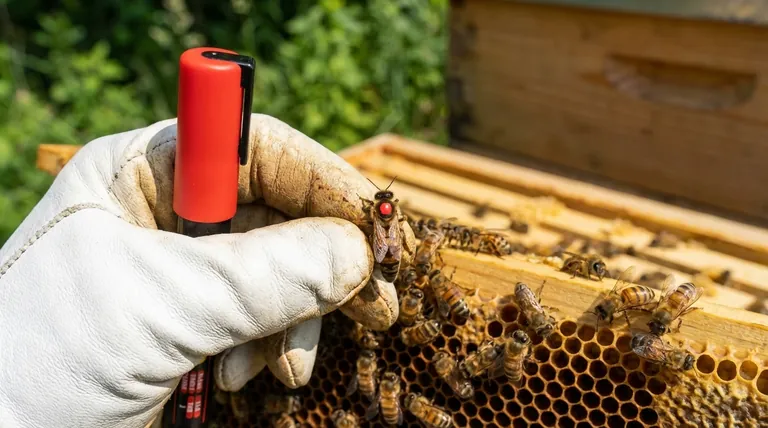In short, marking a queen bee is a foundational practice for efficient and effective hive management. It transforms a time-consuming search into a quick, glanceable assessment, providing immediate insight into the colony's health, stability, and recent history.
The core benefit of marking a queen is not just about finding her faster; it's about converting uncertainty into data. A simple spot of color allows a beekeeper to instantly verify the hive's status and make informed decisions without prolonged disruption to the colony.

The Core Advantages of a Marked Queen
The act of marking a queen provides several layers of information that are crucial for proactive beekeeping. It saves time, reduces stress on the bees, and gives you a clear window into the inner workings of the hive.
Instantaneous Identification
The most obvious benefit is the speed at which you can locate the queen during an inspection. Sifting through tens of thousands of bees to find one individual can be difficult and stressful for both the beekeeper and the colony.
A brightly colored mark on her thorax makes her stand out immediately. This reduces the time the hive is open, minimizing disturbance and defensiveness.
Verifying Queen Presence and Health
Quickly spotting your marked queen confirms that your hive is queenright—the essential first step of any inspection.
Once found, you can easily assess her physical condition and, more importantly, her laying pattern. A healthy, well-marked queen surrounded by a solid pattern of brood is the clearest sign of a thriving colony.
Detecting Swarming and Supersedure Events
A marked queen is your best tool for understanding colony succession. If you can't find your marked queen but discover a new, unmarked queen, you know the hive has either swarmed or superseded (replaced) her.
This is critical information. It tells you that you may need to manage a recent swarm or assess why the colony decided to replace its previous leader. Without a mark, you might never know a change occurred.
Understanding the Risks and Realities
While the benefits are significant, it's important to approach the task with a clear understanding of the minimal risks involved. The primary concern is not rejection by the hive, but the physical act of marking itself.
The Myth of Rejection
A common fear is that the other bees will reject or harm the queen due to the paint scent. When done correctly with the proper, non-toxic marking pen, this is not an issue.
The bees quickly accept her back into the colony, and the mark does not interfere with her mating flights or daily activities.
The Risk of Injury During Marking
The greatest risk is accidentally harming the queen during the marking process. Whether you choose to mark her directly on the frame or gently pick her up, a steady hand and calm demeanor are essential.
Applying too much pressure can injure her legs or abdomen. The goal is a quick, gentle application of paint to the hard thorax (the middle section of her body).
Making the Right Choice for Your Hive
Deciding to mark your queen is a strategic choice that pays dividends in information and efficiency. The benefits are tied directly to your management goals.
- If your primary focus is time-saving and reduced hive stress: Marking is non-negotiable, as it dramatically shortens inspection times.
- If your primary focus is colony health and stability: Marking provides the fastest way to confirm your hive is queenright and to diagnose potential swarming or supersedure issues.
- If your primary focus is performance tracking: Using the international color code (a specific color for each year) allows you to track queen age and make proactive decisions about requeening.
Ultimately, marking your queen bee empowers you to manage your colonies with confidence and clarity.
Summary Table:
| Benefit | Key Insight |
|---|---|
| Instant Identification | Quickly locate the queen, minimizing hive disruption and inspection time. |
| Verify Queen Status | Instantly confirm the hive is queenright and assess the queen's health and laying pattern. |
| Track Swarming/Supersedure | Easily detect if the colony has swarmed or replaced its queen by spotting a new, unmarked queen. |
| Performance Tracking | Use the international color code to track queen age and plan for proactive requeening. |
Ready to manage your apiary with greater confidence and efficiency?
As a trusted wholesale supplier to commercial apiaries and beekeeping equipment distributors, HONESTBEE provides the high-quality, non-toxic queen marking kits and other essential supplies you need for precise hive management. Our products are designed for durability and ease of use, helping you protect your valuable queens and maximize the productivity of your operation.
Let's discuss your supply needs — contact our team today to learn more about our wholesale-focused solutions!
Visual Guide

Related Products
- Queen Bee Marking Pen POSCA Queen Marking Pens for Beekeeping Bee Markers
- Queen Bee Marking Pen UNI Medium Point for Queen and Bee Marking
- Queen Bee Marking Tube Cage Bottle Catcher Holder with Clear Plastic Plunger Marker
- Professional Engraved Round Hive Number Tags for Beekeeping
- Professional Galvanized Hive Strap with Secure Locking Buckle for Beekeeping
People Also Ask
- Where is the queen bee typically marked? A Guide to Safe & Effective Queen Identification
- What is the purpose of a queen marking pen in beekeeping? Essential for Efficient Hive Management
- What are the benefits of marking a queen bee? Boost Efficiency & Hive Health
- What should you do immediately after marking a bee? Ensure a Clean, Durable Mark with This Key Step
- What are the benefits of learning to mark your own queen bees? Boost Your Apiary's Efficiency and Confidence



















